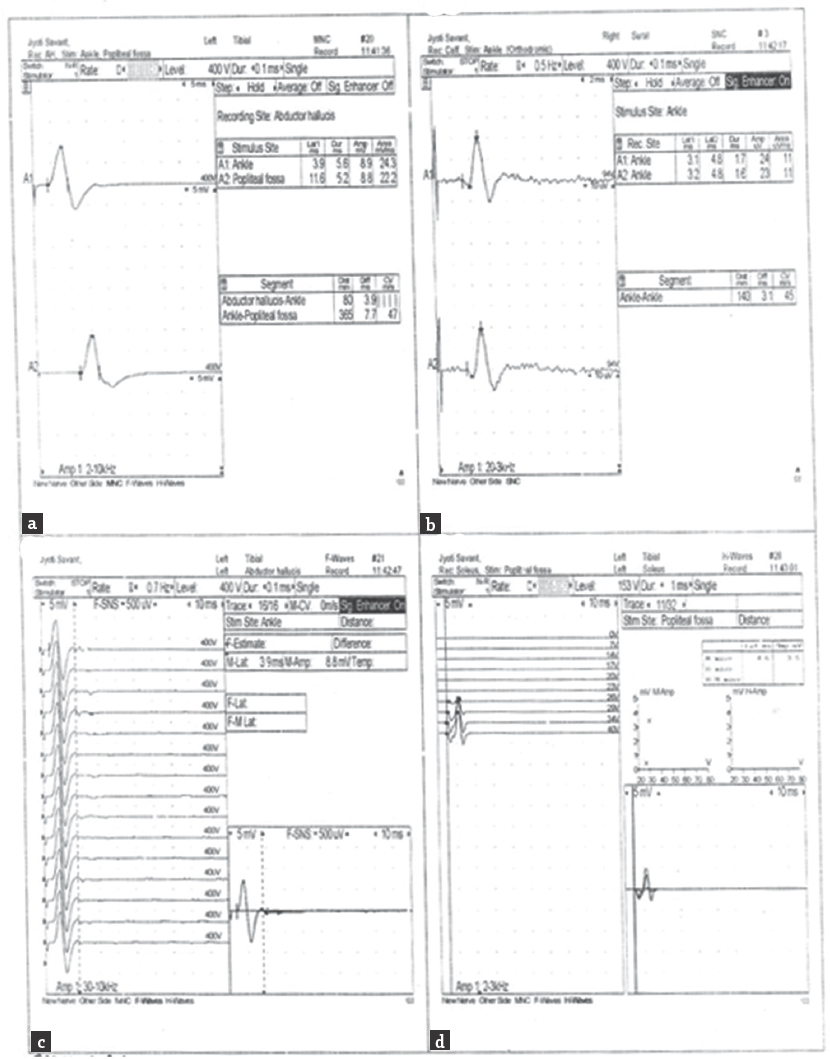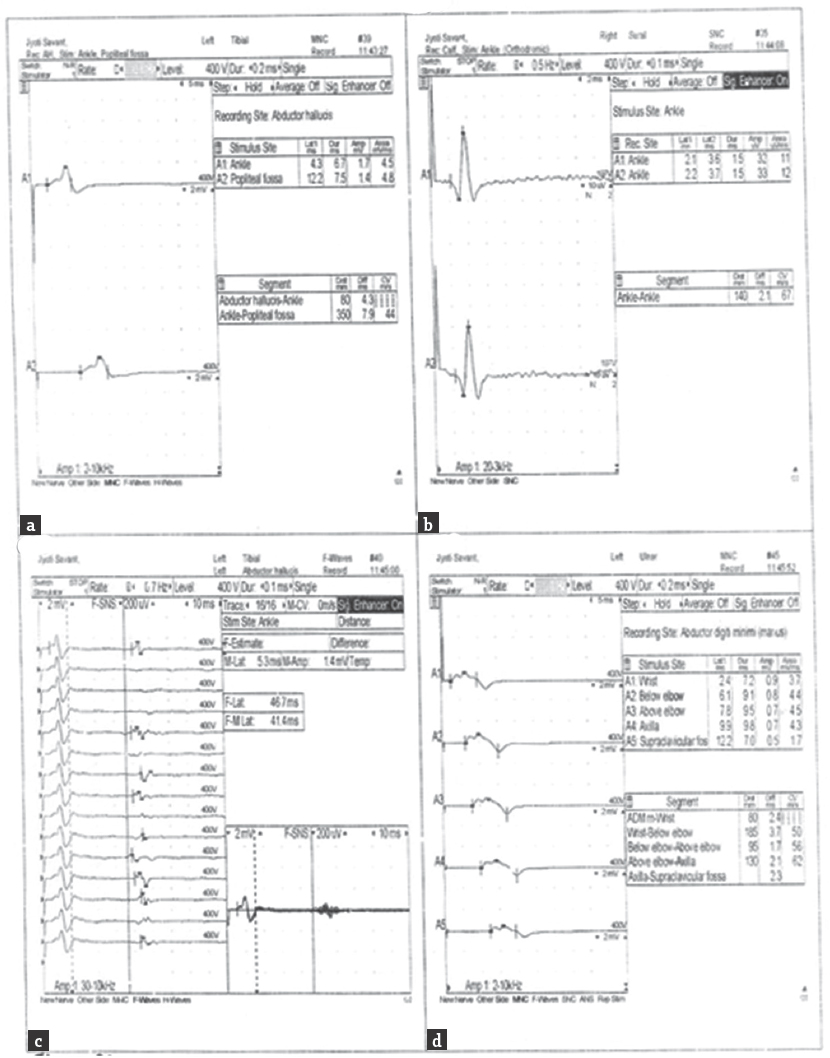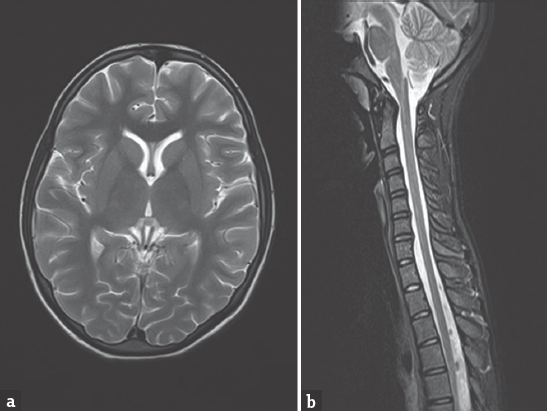Translate this page into:
Guillain–Barre Syndrome following Tuberculosis: A Rare Association
Address for correspondence: Dr. Dinesh Chouksey, Department of Neurology, Sri Aurobindo Medical College and PGI, Indore - 453 555, Madhya Pradesh, India. E-mail: dineshmd09@yahoo.com
This is an open access article distributed under the terms of the Creative Commons Attribution-NonCommercial-ShareAlike 3.0 License, which allows others to remix, tweak, and build upon the work non-commercially, as long as the author is credited and the new creations are licensed under the identical terms.
This article was originally published by Medknow Publications & Media Pvt Ltd and was migrated to Scientific Scholar after the change of Publisher.
Abstract
The co-occurrence of Guillain–Barre syndrome (GBS) and tuberculosis is rare. Even in countries like India, where tuberculosis is common, there is only one case report of co-occurrence of GBS with tuberculosis. We report a case of GBS in association with sputum-positive pulmonary tuberculosis. The earliest treatment with intravenous immunoglobulin in acute motor axonal neuropathy variant of GBS would show good early recovery despite associated pulmonary tuberculosis.
Keywords
Guillain–Barre syndrome
nerve conduction studies
tuberculosis
INTRODUCTION
Guillain–Barre syndrome (GBS) is an acute, monophasic, symmetrically progressive, peripheral ascending demyelinating polyneuropathy characterized by rapidly evolving symmetrical limb weakness, areflexia, absent or mild sensory signs, and variable autonomic disturbances. It is the major cause of acute neuromuscular paralysis, with an annual incidence of 0.4–4/100,000 worldwide. The association of GBS with various gastrointestinal and respiratory tract infections is well established.[2]
The peripheral nerve involvement in patients with tubercular infection is uncommon,[1] and it is attributed to malnutrition and neuropathic effects of antitubercular therapy. However, GBS in association with pulmonary tuberculosis is rarely described.
CASE REPORT
A 16-year-old girl presented to us with acute onset, progressive, ascending, predominantly motor, quadriparesis with truncal weakness for the last 24 h. There was no facial or bulbar involvement. Bladder and bowel functions were normal. She was diagnosed to have pulmonary tuberculosis (sputum positive) 1 week prior to presentation and was taking antitubercular drugs (isoniazid, rifampicin, pyrazinamide, and ethambutol) since then.
On examination, she had symmetric, pure motor, areflexic, lower motor neuron-type quadriparesis (upper limb muscle power Medical Research Council [MRC] Grade III and lower limb MRC Grade II) without facial and bulbar involvement.
Nerve conduction studies done on the 2nd day of onset of symptoms revealed absent H-reflexes from both soleus muscles. The F-wave studies showed absent or impersistent F-responses [Figure 1]. Other motor nerve conduction parameters including distal latencies, amplitudes of compound muscle action potentials (CMAPs), and conduction velocities were normal, and sensory nerve conduction parameters were normal [Figure 2].

- Nerve conduction study graph (Day 2 of illness) (a) left tibial CMAP (b) right sural SNAP (c) left tibial F wave (d) left solecus H reflex

- Nerve conduction study graph (Day 11th of illness) (a) left tibial CMAP (b) right sural SNAP (c) left tibial F wave (d) left ulnar CMAP
Her hematological and biochemical profile including complete blood count, serum electrolytes, liver function test, and renal function test were normal. Her erythrocyte sedimentation rate was increased at 26 mm/h. Serological tests for HIV, hepatitis B, and antinuclear antibody were negative. Urine analysis for porphobilinogen was negative. Chest X-ray showed bilateral parahilar lymphadenopathy. Sputum and bronchoalveolar lavage revealed the presence of acid-fast bacilli on microscopic examination with Ziehl–Neelsen staining. Cerebrospinal fluid (CSF) examination on the 2nd day of symptom onset was normal. Magnetic resonance imaging (MRI) of brain and spine with contrast was normal [Figure 3a and b].

- (a) Magnetic resonance imaging – T2 axial brain image (b) magnetic resonance imaging – T2 spine sagittal
The diagnosis of GBS was made she was treated with intravenous immunoglobulins (IVIG) on the 3rd day of illness at a dose of 0.4 g/kg/day for 5 days and antitubercular drugs.
Repeat CSF study after 1 week of illness revealed albumin-cytological dissociation. Repeat nerve conduction studies after 10 days of onset showed decreased amplitudes of CMAPs with normal distal latencies and conduction velocities [Figure 2].
She showed improvement in muscle strength after 3 weeks of hospitalization. At the time of discharge from hospital, her muscle power was MRC Grade IV in the upper as well as lower limbs.
DISCUSSION
GBS is a postinfectious, immune-mediated disease. Both cellular and humoral immune mechanisms play a role in its pathogenesis. Many of the identified infectious agents are thought to trigger antibody production against ganglioside and glycolipids of myelin through molecular mimicry and cross-reactivity.[4]
The co-occurrence of GBS and tuberculosis is rarely described in literature. In our case, a patient of sputum-positive pulmonary tuberculosis developed GBS subsequently.
In a review of 1100 cases of GBS, Leneman reported tuberculosis as an associated illness in only eight cases.[5] The review again highlights the rarity of this association. Peiris et al. reported a case in which tuberculous granulomata and the tubercle bacillus were demonstrated in the nerve roots at biopsy in a patient who presented with the salient features of GBS. Vyravanathan and Senanayake. reported two cases of tuberculosis with GBS, and they proposed that a cell-mediated hypersensitivity reaction, or invasion of the nerve root by tubercular bacilli, would seem to be the likely explanation of the neuropathy.[6]
Patients of tubercular radiculomyelitis present with root pain, paresthesias, bladder disturbance, and muscle wasting; subsequent paralysis develops, usually after a few days. It is not uncommon to find absent deep tendon reflexes with flaccidity in the lower limbs and the presence of extensor plantar response. In our case, absence of signal changes, no contrast enhancement on MRI, and absence of inflammatory cells in CSF ruled out the possibility of tubercular radiculomyelitis. Further serial nerve conduction studies confirmed the diagnosis of axonal variant of GBS.
The prognosis for recovery is worse in axonal variants of GBS as compared to demyelinating type. Canham and Iseman. reported a case of pulmonary tuberculosis associated with GBS, who recovered over 7 months after treatment with IVIG.[1] Despite medical treatment, GBS often remains a severe disease; about 3–10% of patients die and 20% are still unable to walk after 6 months. In addition, many patients have pain and fatigue that can persist for months or years.[3] Our case showed fast recovery after treatment, probably due to early start of therapy with IVIG, within the 1st week of illness.
Taha et al. reported a case of GBS with unremitting cough and confirmed tubercular infection by bronchoscopy and bronchoalveolar lavage examination.[7] Early bronchoscopic sampling might be worth considering in patients with the suspicion of pulmonary infection since early treatment of specific infections may change the morbidity and mortality. Our patient too showed excellent response to IVIG therapy along with anti-tubercular drugs.
CONCLUSION
To the best of our knowledge, the patient we report is the one of the few cases of GBS with microbiological confirmation of pulmonary tuberculosis in a young Indian girl. It remains a question whether tuberculosis is a contributory factor in the development of GBS. Further possibility of tubercular radiculomyelitis in such cases makes the situation debatable. The reports of the co-occurrence of tuberculosis and GBS have been rarely published from different parts of the world in the past. We wish to draw the attention of clinicians and researchers to consider tuberculosis as a possible associated condition when evaluating patients with GBS.
Financial support and sponsorship
Nil.
Conflicts of interest
There are no conflicts of interest.
REFERENCES
- Guillain-Barré syndrome related to pulmonary tuberculosis. Ann Am Thorac Soc. 2014;11:855-7.
- [Google Scholar]
- Guillain-Barre syndrome associated with pulmonary tuberculosis. J Med Cases. 2013;4:696-8.
- [Google Scholar]
- Clinical features, pathogenesis, and treatment of Guillain-Barré syndrome. Lancet Neurol. 2008;7:939-50.
- [Google Scholar]
- The Guillain-Barré syndrome. Definition, etiology, and review of 1, 100 cases. Arch Intern Med. 1966;118:139-44.
- [Google Scholar]
- Guillain-Barré syndrome associated with tuberculosis. Postgrad Med J. 1983;59:516-7.
- [Google Scholar]
- Guillain-Barré syndrome associated with pulmonary tuberculosis. BMJ Case Rep 2012 2012:pii:Bcr0120125484.
- [Google Scholar]






